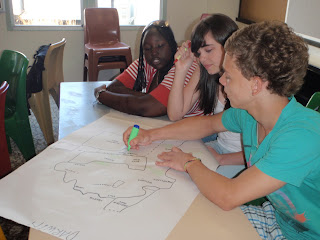Like I mentioned in the previous blog, the 'Our Lives' project has activities or 'research tools' that we use to get young people to discuss any issue that they feel are the most pertinent to them or ones that they believe are affecting them the most right now. These include the Community Risk Mapping Exercise and the Body Mapping Activity. We chose these two because they have been found to be quite effective at engaging young people to discuss issues related to sexual health, risks and risk-taking behaviours from a related pilot study conducted by Save the Children Australia Programs East Kimberley Division called 'Risky Business: Sexual Health Youth Programs East Kimberley', in which I was the Research Officer for, where the aim was to develop and trial innovative and creative strategies to determine their effectiveness at engaging youth - particularly Indigenous youth - at discussing issues that are quite sensitive in nature. So, from that particular project, the Research Team decided to incorporate the Community Risk Mapping and Body Mapping Activities in the 'Our Lives' project because it just seemed like a pretty good fit.
1) Community Risk-Mapping: Where young people identify areas where they feel safe, unsafe, and where they hang out. Young people get to discuss any issue that they feel are quite pressing at the moment and talk about how to overcome them as a group. In this way, they are learning from one another on possible ways of avoiding partaking in risky behaviours, and also a way for them to articulate how they believe some of their issues could be appropriately addressed by the relevant service providers or agencies.
2) Body Mapping: Where young people paint/draw their embodied perceptions of risks. This is quite a creative activity, where the participants discuss how some of the issues they identified in the Community Risk Mapping Exercise in terms of how that affects their bodily health. It's a really great way to get stories or anecdotes of young people's experiences of certain health risks - and other types of risks for that matter - because really they perceive the exercise as just drawing and 'yarning' (talking), which is really what the activity aims to do.
These activities are not structured at all. There are no set questions or anything like that. It's all up to the participants on what they want to talk about. If they don't want to talk about sexual health for a variety of reasons, they don't have to. That's why these activities are considered non-invasive and youth-friendly. Also, these activities allow young people to provide new and up-to-date information regarding risks that they face within their respective towns/communities - if they feel comfortable - which is great because there are a lot of things that youth service providers and other related agencies don't know about the everyday lives of young people. More importantly, because they're not set in a formal classroom context, the participants are more engaged with the activity, and it has been observed that they are learning from each other just by asking questions, talking - and sometimes debating - about youth issues, and generally engaging in discussions with the facilitators and with one another. Due to the informal nature of these sessions, it's quite interesting to hear the conversations that come up!
Cheers from Our Lives,
Nia





No comments:
Post a Comment